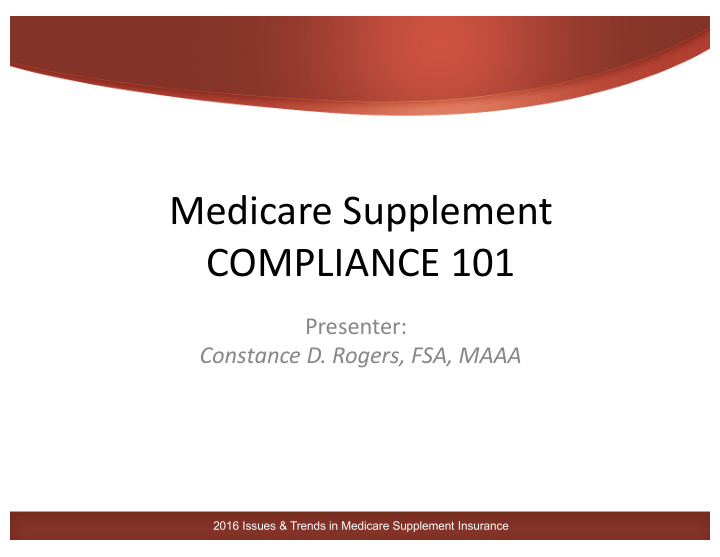



Medicare Supplement COMPLIANCE 101 Presenter: Constance D. Rogers, FSA, MAAA 2016 Issues & Trends in Medicare Supplement Insurance
GOALS • Overview of MedSup compliance issues for beginners • Looking at the topic from 4 perspectives: – Actuarial – Forms – Operations – Marketing 2016 Issues & Trends in Medicare Supplement Insurance
What Coverage Can Be Issued? • “Cards to Play” in each State – Plan Level (11 standardized “plans”) • A, B, C, D, F, F-HD, G, K, L, M, N – Type Level (4 “types”) • Individual Standard • Group Standard • Individual Select • Group Select 2016 Issues & Trends in Medicare Supplement Insurance
• Form Level – Up to 5 forms allowed per Plan / Type for variations in: Innovative Benefits Marketing Method Underwriting Method Covering Disabled Beneficiaries 2016 Issues & Trends in Medicare Supplement Insurance
11 Plans x 4 Types x 5 Variants 220 options theoretically BUT ... very few carriers actually offer more than 2 forms per Plan / Type, and few carriers offer all 11 Plans. 2016 Issues & Trends in Medicare Supplement Insurance
Grandfathered States • Three states do not use the Standardized Plan definitions: • WI • MA • MN 2016 Issues & Trends in Medicare Supplement Insurance
What Underwriting is Allowed? Ages 66+ Age 65 • In most states, FULL • “aging in” UNDERWRITING is allowed • NO UNDERWRITING during unless Guaranteed Issue Open Enrollment (first 6 circumstances (63d months after enrollment in window). Medicare Part B) • In Anniversary Rule state (MO) or Birthday Rule states (CA, OR), NO UNDERWRITING for 30 days around annual policy anniversary or birthday 2016 Issues & Trends in Medicare Supplement Insurance
Underwriting (cont’d) • Under-age 65 – Eligible for Medicare due to Disability or ESRD – Many states mandate Open Enrollment period – States differ regarding whether all Medicare- eligible u65s or just Disabled u65s (excluding ESRDs) – Full Underwriting is allowed outside the Open Enrollment period (or in states with no OE mandate). 2016 Issues & Trends in Medicare Supplement Insurance
What Rates are Allowed? • Age Rating Structure – Most states allow Iss Age, Attd Age, or Community – Some states disallow Attd Age (e.g., FL, AZ, GA, MO, ID) – Some states require Community (e.g., AR, CT) • Gender Rating – Generally allowed, but some states (e.g., CA) require uni-gender rating 2016 Issues & Trends in Medicare Supplement Insurance
Rating (cont’d) • Tobacco Rating – Generally allowed – Some states disallow Tobacco rates for OE / GI issues • Family Status – Discounts may be given for individuals living in community or as members of a multi-policy household 2016 Issues & Trends in Medicare Supplement Insurance
Rating (cont’d) • Underwriting Class – Preferred / Standard / Substandard may be assigned outside of OE / GI windows. – Inside OE / GI window, Preferred rates must be used if offered. • Geographic Region – Allowed within most states and is generally used where allowed. 2016 Issues & Trends in Medicare Supplement Insurance
Rating (cont’d) • Under-65s – States vary: • Some require full subsidization • Others allow full rate loads • Many in between – Some states allow separate rates for Disabled- u65s and ESRD-u65s. 2016 Issues & Trends in Medicare Supplement Insurance
Rating (cont’d) • Can the rate structure be changed? – Yes, but need to demonstrate actuarial equivalency between the 2 structures and guarantee that future rate increases will be the same for both structures. – If not, => discontinuance => 5-year blackout. • Annual Filing – Required, even if rates are not changing 2016 Issues & Trends in Medicare Supplement Insurance
What MLRs are Required? • Individual: 65% lifetime and py3+ • Group: 75% lifetime and py3+ • Same for Standard and Select • Primary enforcement via annual rate filings • Secondary enforcement via annual refund filing reports 2016 Issues & Trends in Medicare Supplement Insurance
What Compensation is Allowed? • Three requirements: – Commission for py1 <= 200% of py2 – Renewal commission runs for at least 5 years* – Only renewal commissions payable for replacement policies • Some states have unique requirements – e.g. IN no variation by plan or by age/gender 2016 Issues & Trends in Medicare Supplement Insurance
What’s the Annual Regulatory Burden? • Rates: Annual rate filings – Must file each year even if not changing rates – Approval needed in all states • NAIC MedSup Experience Exhibits – Annual reporting of experience for the calendar year – Included at the back of the Annual Statement – Filed for each unique State / Plan / Type combination – Combine across 1990 and 2010 product eras – Usually due to accounting department in late January each yr – Easily automated with actuarial review and sign-off 2016 Issues & Trends in Medicare Supplement Insurance
What’s the Annual Regulatory Burden? (cont’d) • Refund Filings – Benchmark Loss Ratio and Refund Filing Reports – Compares ITD loss ratio to a calculated benchmark loss ratio – Filed for each State / Plan / Type – Combined across 1990 and 2010 product eras – Credibility adjustments are included – Must be submitted by May 31 st of each year – Easily automated with actuarial review and sign-off – Should form a feedback loop to your pricing actuaries 2016 Issues & Trends in Medicare Supplement Insurance
Recommend
More recommend